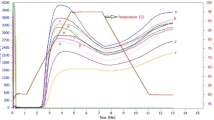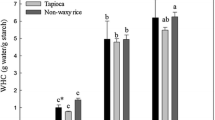Abstract
Thermal alkaline treatment, normally used for corn, was applied to pigeonpea grains. Starch granules were isolated using wet milling and alkaline treatments. Effects of the calcium hydroxide [Ca(OH)2] concentration in the range of 0–1% (w/v) on granule structure, crystalline structure, chemical composition, and physicochemical, thermal, and pasting properties of isolated starch granules were determined. Compared to native samples, thermal alkaline treated samples had higher protein, lipid, calcium, and phosphorus contents, but lower starch and amylose contents. Thermal alkaline treatment increased starch granular size and gelatinization temperatures, but decreased relative crystallinity, gelatinization enthalpy, swelling power, solubility, amylose leaching, and the pasting viscosity. Amylose-lipid complexes were not found in thermal alkaline treated flours. As the Ca(OH)2 concentration increased, the amylose content, relative crystallinity, gelatinization temperature, and enthalpy also increased, but the swelling power, solubility, amylose leaching, and paste viscosity decreased. A higher Ca(OH)2 concentration produced more stable starch granules that resisted re-gelatinization.
Similar content being viewed by others
References
Mendez-Montealvo G, Sánchez-Rivera MM, Paredes-López O, Bello-Pérez LA. Thermal and rheological properties of nixtamalized maize starch. Int. J. Biol. Macromol. 40: 59–63 (2006)
Mendez-Montealvo G, Trejo-Espino JL, Paredes-López O, Bello-Pérez LA. Physicochemical and morphological characteristics of nixtamalized maize starch. Starch-Starke 59: 277–283 (2007)
Sefa-Dedeh S, Cornelius B, Sakyi-Dawson E, Afoakwa EO. Effect of nixtamalization on the chemical and functional properties of maize. J. Food Chem. 86: 317–324 (2004)
Rojas-Molina I, Gutiérrez E, Rojas A, Cortés-Álvarez M, Campos-Solís L, Hernández-Urbiola M, Arjona JL, Cornejo A, Rodríguez-García ME. Effect of temperature and steeping time on calcium and phosphorus content in nixtamalized corn flours obtained by traditional nixtamalization process. Cereal Chem. 86: 516–521 (2009)
Gómez MH, McDonough CM, Rooney LW, Waniska RD. Changes in corn and sorghum during nixtamalization and tortilla baking. J. Food Sci. 54: 330–336 (1989)
Gómez MH, Waniska RD, Rooney LW. Starch characterization of nixtamalized corn flour. Cereal Chem. 68: 578–582 (1991)
Mondragón M, Bello-Pérez LA, Agama E, Melo A, Betancur-Ancona D, Peña JL. Effect of nixtamalization on the modification of the crystalline structure of maize starch. Carbohyd. Polym. 55: 411–418 (2004)
Gómez MH, Waniska RD, Rooney LW. Effects of nixtamalization and grinding conditions on starch in masa. Starch-Starke 42: 475–482 (1990)
Pineda-Gómez P, Rosales-Rivera A, Rodríguez-García ME. Modeling calcium and water intake in threshed corn grain during thermo-alkaline treatment. J. Food Eng. 113: 434–441 (2012)
Rodríguez ME, Yáñez-Limón M, Alvarado-Gil JJ, Vargas H, Sánchez-Sinencio F, Figueroa JDC, Martínez-Bustos F, Martínez-Montes J L, González-Hernández J, Silva MD, Miranda LCM. Influence of the structural changes during alkaline cooking on the thermal, rheological, and dielectric properties of corn tortillas. Cereal Chem. 73: 593–600 (1996)
Mondragón M, Mendoza-Martýnez AM, Bello-Perez L A, Pena JL. Viscoelastic behavior of nixtamalized maize starch gels. Carbohyd. Polym. 65: 314–320 (2006)
González R, Reguera E, Mendoza L, Figueroa JM, Sánchez-Sinencio F. Physicochemical changes in the hull of corn grains during their alkaline cooking. J. Agr. Food Chem. 52: 3831–3837 (2004)
Norton G, Bliss FA, Bressani R. Biochemical and Nutritional attributes of grain legumes. pp. 73–114. In: Grain Legume Crops. Summerfield RJ, Roberts EH. (eds). Collins and Sons, Ltd., Collins, London, UK 1985)
Nwokolo E. Nutritional evaluation of pigeon pea meal. Plant. Foods Hum. Nutr. 37: 283–290 (1987)
Duhan A, Khetarpaul N, Bishnoi S. Content of phytic acid and HCl-extractability of calcium, phosphorus and iron as affected by various domestic processing and cooking methods. Food Chem. 78: 9–14 (2002)
Lawal OS, Adebowale KO. Physicochemical characteristics and thermal properties of chemically modified jack bean (Canavalia ensiformis) starch. Carbohyd. Polym. 60: 331–341 (2005)
Nayouf M, Loisel C, Doublier JL. Effect of thermomechanical treatment on the rheological properties of cross linked waxy corn starch. J. Food Eng. 59: 209–219 (2003)
AOAC. Official methods of analysis of AOAC Intl. 18th ed. Association of Official Analytical Communities, Gaithersburg, MD, USA (2005)
Holm J, Björck I, Drews A, Asp NG. A rapid method for the analysis of starch. Starch-Starke 38: 224–226 (1986)
Juliano BO. A Simplified assay for milled rice amylose. Cereal Sci. Today 16: 334–360 (1971)
Heyns K. Einheitliche analysen methoden für stärke und stärke hydrolysen produkte. Starch-Starke 11: 251–271 (1959)
Nara S, Komiya T. Studies on the relationship between water-saturated state and crystallinity by the diffraction method for moistened potato starch. Starch-Starke 35: 407–410 (1983)
Mestres C, Matencio F, Pons B, Yajid M, Fleidel GA. Rapid method for the determination of amylose content by using differential scanning calorimetry. Starch-Starke 48: 2–6 (1996)
Ceballos H, Sanchez T, Morante N, Fregene M. Dufour D, Smith A, Denyer K, Perez J, Calle F, Mestres C. Discovery of an amylosefree starch mutant in cassava (Manihot esculenta Crantz). J. Agr. Food Chem. 55: 7469–7476 (2006)
ISO 6647-2. Determination of Amylase Content, Part 2. Routine Method. International Organization for Standardization, Geneva, Switzerland. pp. 1–13 (2003)
Oosten BJ, Breda. Interactions between starch and electrolytes. Starch-Starke 42: 327–330 (1990)
Guzmán AQ, Flores MEJ, Escobedo RM, Guerrero LC, Feria JS. Changes on the structure, consistency, physicochemical and viscoelastic properties of corn (Zea mays sp.) under different nixtamalization conditions. Carbohyd. Polym. 78: 908–916 (2009)
Reguera E, Yee-Madeira H, Fernández J, Sánchez-Sinencio F. On the state of Ca in nixtamalized corn grains. pp. 221–238. In: Topics in Contemporary Physics. Heras JA, Jiménez RV (eds). Monash Litho, Mexico, DF, Mexico (2000)
French D. Organization of starch granules. Vol. II, pp. 183–207. In: Starch: Chemistry and Technology. Whistler RL, BeMiller JN, Paschall EF (eds). Academic Press, Orlando, FL, USA (1984)
Horng JL. The isolation and characterization of starches from legume grains and their application in food formulations. PhD Thesis, RMIT University, Melbourne, Australia (2007)
Hoover R, Swamidas G, Vasanthan T. Studies on the physicochemical properties of native, defatted, and heat-moisture treated pigeon pea (Cajanus cajan L.) starch. Carbohyd. Res. 246: 185–203 (1993)
Rendleman JA. Metal-polysaccharide complexes-Part II. Food Chem. 3: 127–162 (1978)
Matsuki J, Park J-Y, Shiroma R, Ike M, Yamamoto K, Tokuyasu K. Effect of lime treatment and subsequent carbonation on gelatinization and saccharification of starch granules. Starch-Starke 64: 452–460 (2012)
Slade L, Levine H, Wang M, Ievolella J. DSC analysis of starch thermal properties related to functionality in low-moisture baked goods. J. Thermal Anal. 47: 1299–1314 (1996)
Author information
Authors and Affiliations
Corresponding author
Rights and permissions
About this article
Cite this article
Roskhrua, P., Tran, T., Chaiwanichsiri, S. et al. Physicochemical properties of thermal alkaline treated pigeonpea (Cajanus cajan L.) flour. Food Sci Biotechnol 23, 381–388 (2014). https://doi.org/10.1007/s10068-014-0053-0
Received:
Revised:
Accepted:
Published:
Issue Date:
DOI: https://doi.org/10.1007/s10068-014-0053-0




